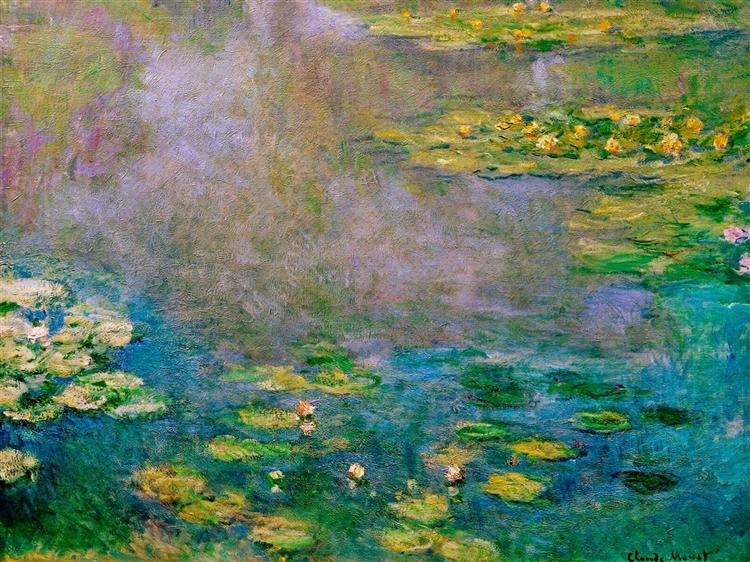Tanım
The work "Water Lilies", painted by Claude Monet in 1906, is a masterful representation of his iconic Impressionist style, where light and color intertwine to create an effective visual experience that surpasses mere observation. Monet, known for his obsession with changing environments of light and color, captures in this painting not only a specific moment in time, but also the very essence of his garden in Giverny, a place that became his laboratory of color and form.
The composition of “Water Lilies” is notable for its use of organic shapes floating against an almost abstract background. The painting succeeds in conveying a sense of tranquility and contemplation, one of the hallmarks of Monet’s work. Rather than a traditional figure- or landscape-centric focus, Monet opts for an enveloping depth that allows the observer to immerse themselves in the water’s surface. The leaves of the water lilies, bright green, are distributed across the entire surface of the canvas, creating a dense network that encloses the viewer in a world of living nature.
The play of colour in this work is another of its fascinating aspects. Monet uses a rich and varied palette, where different shades of green are combined with deep blues and subtle violets. This use of colour not only highlights the beauty of the water and vegetation, but also establishes a dynamic dialogue between the different shades, which seem to vibrate thanks to the loose brushstroke technique characteristic of Impressionism. The interactions of light falling on the surface of the water evoke a sense of movement and ephemerality, creating an almost lyrical experience that invites meditation.
It is interesting to note that there are no human characters in this work, which is characteristic of many of Monet's water lily paintings. Instead of including figures, the painter focuses on the relationship between nature and the viewer's perception, a decision that enhances immersion in the aquatic landscape. This reinforces the theme of Impressionism, which focuses on the subjective experience of the natural world and changing light.
Throughout his career, Monet continually explored the theme of water lilies, creating approximately 250 works on this motif, which speaks to his deep fascination with light and water. The “Water Lilies” are not only a pictorial series, but also part of his legacy in artistic modernity. This pictorial journey culminated in the creation of a series of murals for the Orangerie space in Paris, where his works are displayed in an environment designed to envelop the viewer in his vision of nature. Monet’s influence on contemporary art is undeniable, having inspired countless artists to explore light, color, and abstraction in their own practices.
The 1906 work is set in a period when Monet was increasingly seeking to delve into abstraction, moving away from figurative representation. This exploration in "Water Lilies" reveals a contemporary visual thought that invites a new kind of interpretation of reality, where the essence of natural elements is revealed through the perception of light and color rather than through defined forms.
In short, Monet's "Water Lilies" is a bridge between Impressionism and pictorial modernity, where simplification and the search for sensorial experience in nature mark a milestone in the development of art. Through his ingenious handling of light and color, Monet creates a work that not only captures the beauty of its surroundings, but also invites the viewer to reflect on their relationship with nature and the visual experience itself.
KUADROS ©, a famous painting on your wall.
Hand-made oil painting reproductions, with the quality of professional artists and the distinctive seal of KUADROS ©.
Painting reproduction service with satisfaction guarantee. If you are not completely satisfied with the replica of your painting, we will refund 100% of your money.

